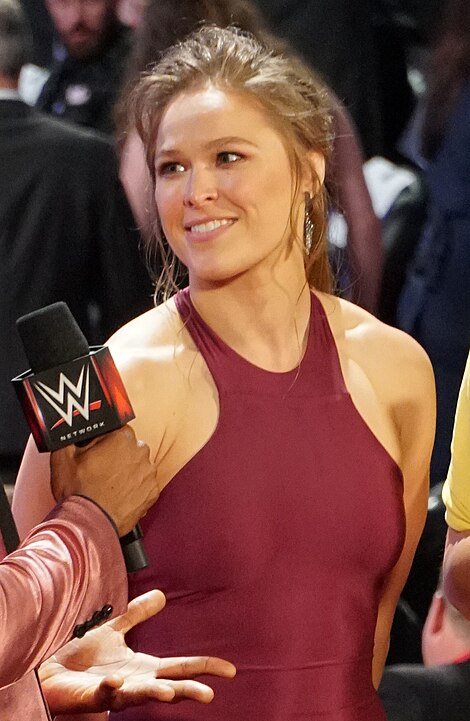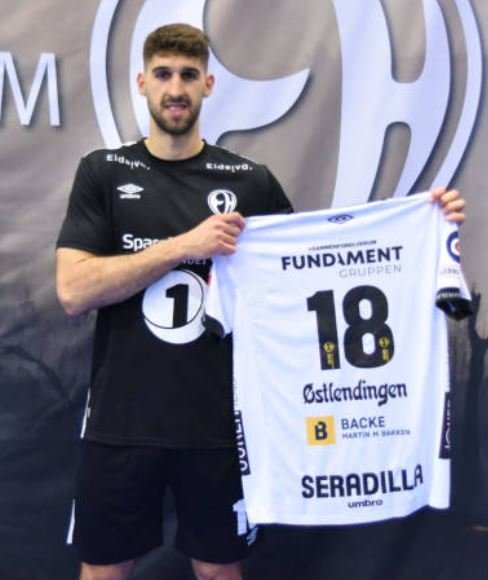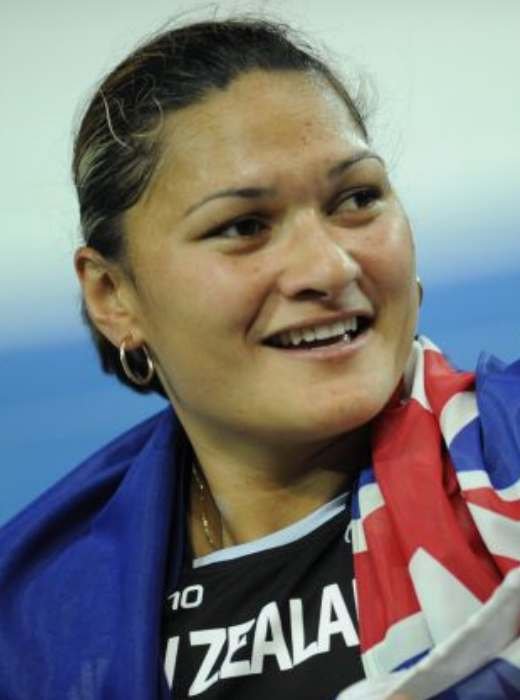How a speech-impaired kid who lost her father to suicide became the most dominant female fighter in history and revolutionized combat sports forever
The moment Holly Holm’s left foot connected with Ronda Rousey’s jaw that November night in 2015, the unthinkable happened: the invincible fell. As Rousey crashed to the canvas of Melbourne’s Etihad Stadium, unconscious before she hit the ground, 56,000 spectators collectively gasped. The woman who had steamrolled through every opponent with mechanical precision – finishing most in under a minute – lay defeated.
But to understand that moment’s true gravity, you need to understand what came before. Because Ronda Rousey’s story isn’t just about winning fights. It’s about a girl who couldn’t speak being told she would never be understood. About a daughter losing her father and finding herself on the judo mat. About an Olympic medalist bartending to make ends meet. And ultimately, about the warrior who changed what people thought was possible for women in combat sports.
This is the story of a fighter in every sense of the word.
Ronda Rousey: Born Fighting
Ronda Jean Rousey’s first opponent was death itself. Born in Riverside, California on February 1, 1987, she entered the world blue and silent, umbilical cord wrapped tightly around her neck. Her Apgar score – the first test of a newborn’s health – registered at zero. As medical staff desperately worked to resuscitate the oxygen-deprived infant, her parents confronted the possibility their daughter might not survive her first minutes.
She did survive, but that initial battle left its mark. The oxygen deprivation caused neurological damage resulting in childhood apraxia of speech, a motor speech disorder that rendered her unable to form intelligible words for the first six years of her life.
“My sisters had to translate my gibberish for everyone,” Ronda Rousey would later reveal. “I couldn’t make myself understood.”
The condition was severe enough that when Rousey was three, her family relocated to Jamestown, North Dakota specifically to access specialized speech therapy at Minot State University. Those early therapy sessions created an unusually close bond with her father, Ron Rousey, who worked extensively with her one-on-one.
“My dad would dedicate hours to helping me practice the most basic sounds,” she once told an interviewer. “He never gave up on me.”
But life wasn’t finished testing young Ronda Rousey’s resilience.
The Fall
When she was eight years old, Ronda’s father took his children sledding – a seemingly innocent family outing that would alter their lives forever. Ron Rousey broke his back in an accident, triggering a rare blood disorder later identified as Bernard-Soulier syndrome. The condition prevented proper healing and promised a grim future: progressive paralysis, constant pain, and eventually death after a prolonged decline.
Facing the prospect of becoming first paraplegic then quadriplegic before dying, Ron made a devastating choice. He took his own life to spare his family the burden of his deteriorating condition.
Ronda Rousey’s mother, AnnMaria De Mars – herself a former World Judo Champion and holder of a Ph.D. in educational psychology – broke the news with clinical directness.
“She just laid the facts out,” Rousey recalled. “‘This is what happened and this is what’s going on.”
The young girl’s coping mechanism was heartbreaking in its simplicity: she convinced herself her father was merely away on business, a psychological defense she maintained for some time. The loss instilled in her a persistent sense of life’s fragility.
“Even if everything is okay,” she would later reflect, “everything could come crashing down at any moment.”
Adding to the weight of this tragedy, Ronda Rousey later discovered her paternal grandfather had also died by suicide, revealing a generational pattern of self-harm in her family. The subject became taboo in her household, with her mother and sisters avoiding discussion of their loss.
In the aftermath, Rousey struggled both academically and emotionally. It would take something extraordinary to redirect her path.
The Dojo as Sanctuary
When Ronda turned 11, her mother made a decision that would change everything: she introduced her daughter to judo, the sport through which AnnMaria herself had made history as the first American to win a World Judo Championship.
The dojo became Rousey’s sanctuary, a place where her speech impediment didn’t matter and where the physical aggression stemming from her emotional pain found constructive outlet. Under her mother’s tutelage, she began mastering the armbar—a joint lock that would later become her signature move in MMA.
Their training partnership wasn’t without incident. After accidentally breaking her mother’s wrist during practice at age 13, Rousey moved to the Hayastan MMA Academy in North Hollywood, training alongside future MMA stars Manny Gamburyan and Karo Parisyan.
The environment was brutally challenging. Ronda Rousey regularly trained with larger male partners and would later recall crying nightly from frustration between 2002-2005. Yet these difficulties forged her technical skills and unparalleled mental toughness.
“I was the only girl there most of the time,” she once said. “I didn’t get special treatment. If anything, they were harder on me.”
Her progress defied all expectations. By 15, she made the U.S. Olympic team. At 16, she became the youngest American to achieve the national No. 1 ranking in women’s half-middleweight division.
Though she didn’t medal at her first Olympics in Athens 2004, losing to eventual silver medalist Claudia Heill, she claimed gold at that year’s World Junior Championships – announcing herself as a prodigy in the sport.
OLYMPIC GLORY
The 2008 Beijing Olympics marked Ronda Rousey’s defining moment in judo. After losing in the quarterfinals to Dutch judoka Edith Bosch, many competitors would have folded. Rousey instead fought through the repechage bracket – a second-chance tournament for those defeated by eventual finalists – to defeat Germany’s Annett Boehm for bronze.
With this victory, she became the first American woman to win an Olympic judo medal since the sport’s introduction to the games in 1992 – a landmark achievement earned through sheer determination.
The financial reality of this historic accomplishment was sobering. Rousey received only $6,000 after taxes for her Olympic medal, highlighting the economic challenges facing amateur athletes. Despite standing on the Olympic podium, she was effectively broke.
She retired from competitive judo at just 21, compiling an impressive record of 56 wins against 19 losses. But the question loomed large: what next?
Ronda Rousey: From the Mat to the Octagon
Post-Olympic life proved unceremonious for the bronze medalist. Rousey worked multiple jobs – bartending and cocktail waitressing – while living in a Venice Beach studio apartment with her dog. The glory of Beijing seemed distant as she struggled to pay rent.
“I was living in my car for a while,” she admitted in a 2015 interview. “I had less than $10,000 to my name.”
Her transition to mixed martial arts began in 2010 under coach Edmond Tarverdyan at Glendale Fighting Club, where she developed the striking skills to complement her elite grappling. The judo champion had found her next competitive home.
Rousey’s MMA debut was nothing short of spectacular. Her first three amateur fights ended via armbar submission in 23, 57, and 24 seconds respectively. Turning professional in 2011, she maintained this dominance, winning her first four pro fights all in under a minute.
Her ruthless efficiency caught the attention of UFC president Dana White, who had famously declared women would never fight in the promotion. Rousey’s star power changed his mind, and in 2012 she became the first woman signed to UFC, subsequently being named the inaugural Women’s Bantamweight Champion.
Changing the Game
The impact was seismic. On February 23, 2013, Ronda Rousey headlined UFC 157 – the promotion’s first women’s bout – defending her title against Liz Carmouche. The event drew 13,000 spectators and 450,000 pay-per-view buys, silencing critics who claimed women’s fights wouldn’t sell.
What followed was arguably the most dominant championship reign in UFC history. Ronda Rousey set records for fastest title defense (14 seconds against Alexis Davis) and most consecutive title defenses by a woman (6), establishing herself as the undisputed face of women’s MMA.
Her rise transcended sports. Rousey appeared in films like “The Expendables 3,” “Furious 7,” and “Entourage.” She graced the covers of ESPN Magazine, Sports Illustrated, and Self. Her autobiography, “My Fight/Your Fight,” became a New York Times bestseller.
But beneath this meteoric public success lay private battles few knew about.
The Hidden Battles
Throughout her career, Ronda Rousey concealed serious health concerns that threatened her fighting future. The numerous concussions sustained during her judo years made her particularly vulnerable to head trauma in MMA.
“I kept my concussion symptoms a secret from everyone, including my coaches and the UFC, to continue fighting,” Rousey later revealed.
She developed a fighting style focused on quick finishes specifically to avoid prolonged exchanges that might exacerbate her neurological issues. This strategy wasn’t just tactical brilliance – it was self-preservation.
Equally hidden was her years-long struggle with bulimia. Beginning at 16 while competing in judo, she developed the eating disorder, hoarding food during weight cuts then binge eating after weigh-ins.
“I would make myself throw up to avoid gaining weight,” she later confessed, describing how the disorder became a coping mechanism for athletic pressures.
This battle was compounded by bullying about her muscular physique during school years, when she would wear hoodies to conceal her arms. “They called me ‘Miss Man’ and made fun of my muscles,” she once revealed. “I spent years being ashamed of my body.”
The irony wasn’t lost on her that the same physique that once made her a target of ridicule later landed her in the Sports Illustrated Swimsuit Issue.
The Fall and the Rise
No champion reigns forever. On November 15, 2015, Holly Holm did what many thought impossible, knocking out the seemingly invincible Rousey with a head kick in the second round.
The defeat devastated Rousey, who later admitted contemplating suicide in its aftermath. “I was literally sitting there thinking about killing myself,” she revealed in a tearful 2016 interview. “In that exact second, I’m like, ‘I’m nothing. What do I do anymore?'”
Her return fight against Amanda Nunes in December 2016 ended in another knockout loss, this time in just 48 seconds. The woman who had once seemed unbeatable had lost twice in devastating fashion.
Many athletes would have been broken by such public failures. Rousey instead found a new arena for her talents.
Reinvention
In 2018, Ronda Rousey debuted in WWE, making a spectacular entrance at WrestleMania 34. She quickly achieved similar dominance in professional wrestling, winning the Raw Women’s Championship and later the SmackDown Women’s Championship.
Her impact on WWE proved as groundbreaking as her UFC career. She competed in the first women’s match to main event WrestleMania (35) and became WWE’s eighth Women’s Triple Crown Champion.
Though she’s been openly critical of WWE’s backstage environment under Vince McMahon’s leadership, calling it a “fundamentally sick environment,” her wrestling accomplishments stand as yet another chapter in a career defined by breaking barriers.
Ronda Rousey’s Life beyond the Spotlight
In 2017, Ronda Rousey married fellow UFC fighter Travis Browne, beginning a new chapter focused on family and personal growth. The couple has faced fertility challenges including two miscarriages before successfully having children through IVF.
Since stepping away from full-time wrestling in 2023, Rousey has focused on regenerative farming in Oregon and various creative pursuits. The fighter who once commanded global attention now finds fulfillment in a quieter life.
“For so long, I defined myself by competition,” she reflected in a recent interview. “Now I’m learning who I am beyond that.”
The Legacy
Ronda Rousey’s journey from speech-impaired child to global sports icon stands as one of the most remarkable transformations in athletic history. She didn’t just win championships – she changed what people believed possible.
Before Rousey, the idea of women headlining UFC events seemed unthinkable. Before Rousey, female fighters were relegated to obscurity. Before Rousey, young girls rarely dreamed of combat sports glory.
Her impact extends beyond her 12-2 MMA record or Olympic medal. It lives in the explosion of women’s participation in martial arts. It lives in the UFC women’s divisions that now feature some of the promotion’s biggest stars. It lives in every girl who walks into a gym without having to prove she belongs there.
Ronda Rousey fought her way back from a traumatic birth, childhood speech impairment, family tragedy, and crushing defeats. She stood on Olympic podiums, UFC championship stages, and WrestleMania main events.
But perhaps her greatest victory isn’t measured in medals or belts. It’s measured in the doors she kicked open – and the millions who walked through them.
“I’m not a perfect role model,” Ronda Rousey once said. “But I am real.”
Real, indeed. And absolutely unforgettable.
If Rousey’s journey of confronting death at birth and rising to combat sports immortality resonates with you, you might find equal inspiration in Brazilian pro surfer Maya Gabeira‘s incredible comeback story. Like Rousey, Gabeira stared death in the face—not in a hospital bassinet but beneath the crushing weight of a 70-foot wave at Nazaré, Portugal, where a wipeout left her unconscious and fighting for survival. Following a grueling recovery from that near-fatal 2013 accident, Gabeira didn’t just return to the sport—she conquered it, breaking the world record for the highest wave ever surfed by a woman. It’s another testament to the indomitable human spirit that defines truly transcendent athletes, those rare individuals who transform their darkest moments into the launching pad for their greatest triumphs.



